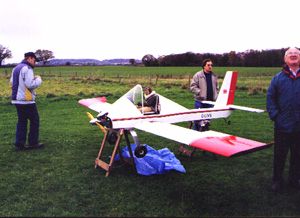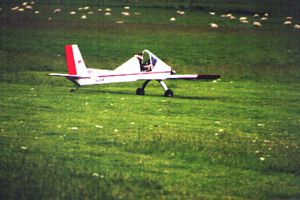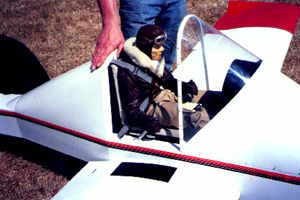

| Livesey DL5 - The Half Scale Homebuild! (Part 2) |
Clwyd Soaring Association
(Read Part 1 Here)
Flying
The DL5
 After
waiting for some weeks to get the right conditions and the exemption certificate
to arrive from the C.A.A. the day to test fly the DL5 the day finally
arrived. Visibility wasn't brilliant but acceptable, a steady 5 knot wind,
a quick phone around to the "crew" and before you know it we
were on the airfield rigging and of course taking photographs, standing
back and doing the obligatory ogling wow, argh, etc. etc.
After
waiting for some weeks to get the right conditions and the exemption certificate
to arrive from the C.A.A. the day to test fly the DL5 the day finally
arrived. Visibility wasn't brilliant but acceptable, a steady 5 knot wind,
a quick phone around to the "crew" and before you know it we
were on the airfield rigging and of course taking photographs, standing
back and doing the obligatory ogling wow, argh, etc. etc.
With a range check out of the way (with and without the engine running) the half gallon fuel tank was fitted and the thirty two inch propeller was flicked profusely, not a murmur. Then a little voice said, "Perhaps it would work if we put the ignition switch on!" Embarrassment! You wouldn't chuckle! With the switch down the engine duly burst into life. It was time to see if all the work had been worthwhile. Lined up into wind, final cheeks, throttle smoothly open and the DL5 was on its way. The tail was soon up, time to ease back on the elevator, the aircraft then rotated and was airborne.
My
emotions were going berserk, however all was not perfect. I had a rearward
centre of gravity situation which made the  aircraft
a little twitchy in pitch but manageable. A little trimming helped but
I realised we needed more weight in the nose; ailerons were really smooth
and the 2 to 1 differential worked fine. Rudder was also good, but the
engine at this stage was running a little rough. The DL5 despite the minor
problems was performing like a dream and looking every bit the part! I
wanted to throw my hands in the air but realised this wasn't such a good
idea! The landing is a mandatory manoeuvre so I planned to do a square
circuit downwind, base leg and onto finals. I decided not to use the flaps
until later. I throttled back and joined the circuit. Performing faultlessly
(even with the C of G out) the DL5 touched down to a perfect three-point
greaser! Now those hands, feet, and everything else went into the air,
my words can't describe how I felt.
aircraft
a little twitchy in pitch but manageable. A little trimming helped but
I realised we needed more weight in the nose; ailerons were really smooth
and the 2 to 1 differential worked fine. Rudder was also good, but the
engine at this stage was running a little rough. The DL5 despite the minor
problems was performing like a dream and looking every bit the part! I
wanted to throw my hands in the air but realised this wasn't such a good
idea! The landing is a mandatory manoeuvre so I planned to do a square
circuit downwind, base leg and onto finals. I decided not to use the flaps
until later. I throttled back and joined the circuit. Performing faultlessly
(even with the C of G out) the DL5 touched down to a perfect three-point
greaser! Now those hands, feet, and everything else went into the air,
my words can't describe how I felt.
With weight added to the nose and the engine running sweeter we were off again. This time the DL5 was a joy; flaps were most efficient up to 15%. Beyond this, in the drag mode, steep approaches were carried out with a little power with superb control throughout. During this second flight tight turns, straight stalls, even a wing over (chandelle) were carried out with complete success. The landing was planned and executed and was in every way as good as the first one. My "affair" with the DL5 was now even more intimate.
 This
is the story so far. I hope to get David Livesey in the flesh to see what
amounts to his creation coming to reality, all be it half the size he
planned. We have more flying to do, and I'm sure it will be very pleasurable.
I owe a great big thank-you to my fellow modelling friends who helped
enormously. Now if I can build it at half scale why can't we go to one
to one scale, the saga continues.
This
is the story so far. I hope to get David Livesey in the flesh to see what
amounts to his creation coming to reality, all be it half the size he
planned. We have more flying to do, and I'm sure it will be very pleasurable.
I owe a great big thank-you to my fellow modelling friends who helped
enormously. Now if I can build it at half scale why can't we go to one
to one scale, the saga continues.
The model has now been flying for a couple of years and seems to perform better with each outing. It has never let me down in any way, shape or form. I have however, changed one or two things, which have added to the performance.
Firstly, the two silencers, which are inside the fuselage in flameproof compartments, have been changed. This, along with a change in the size of the prop, this is now a 28' x 8" and has improved the aircraft and engine performance dramatically. They do say we live and learn.
The original tail wheel I constructed, proved as useful as an ashtray on a motorbike! It just would not respond but I was never a fan of castoring tail wheel units. After a little brain teasing the current unit works very well and is very rugged.
 The
last addition was in the radio department and this was fitted in between
the receiver and flap servos and to give it its full title it is the JR
digital programmable servo rate limiter/sequencer. This can limit the
transition time from 0 - 25 seconds and is very useful on flaps, undercarriage
doors etc. Certainly on the flaps of this model, it has made the trim
change when applying the flaps a much more relaxed affair and I would
highly recommend similar applications.
The
last addition was in the radio department and this was fitted in between
the receiver and flap servos and to give it its full title it is the JR
digital programmable servo rate limiter/sequencer. This can limit the
transition time from 0 - 25 seconds and is very useful on flaps, undercarriage
doors etc. Certainly on the flaps of this model, it has made the trim
change when applying the flaps a much more relaxed affair and I would
highly recommend similar applications.
The DL5 is still operational although I don't take it out as much as I'd like because it does take a 'crew' to help, but it is well worth the effort when the occasion arises.
I recently flew it at a display and was approached a couple of hours after the flying slot by a chap with his wife. He had been told on the flight line this was a model and not a full size being demonstrated, He insisted on seeing the model to satisfy himself it really was a model and he was not being 'wound up!' Having shown him around the model and with a big smile he said, "I really must get into this hobby!" Enough said I think.
Happy
Landings.
(Read Part 1 Here)
Ray Jones
Clwyd Soaring Association